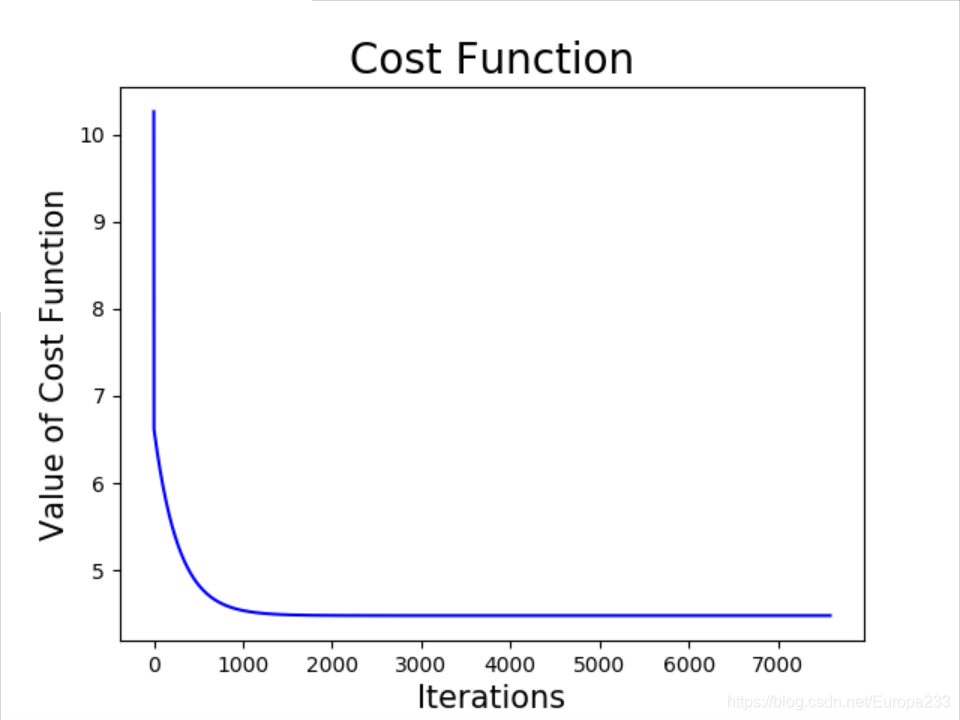【写在前面】
最近刚刚学了python,用来写了下吴恩达老师机器学习第一次作业,没有用别人写好的框架,地址是:
https://github.com/Europe233/ml_homework_py/tree/master/exercise1
【结果展示】
首先给出单变量下的拟合效果:


梯度下降法和 Normal Equation 方法结果对比:

多变量拟合:

梯度下降法和 Normal Equation 方法结果对比:

【代码】
gradientDescent.py
import numpy as np
def gradient_theta(theta,x,y):
"""返回参数的梯度(其反方向即为下一步迭代的搜索方向)"""
m=y.size
gra_theta = np.dot(np.dot(theta.T,x.T),x) - np.dot(y.T,x)
gra_theta = gra_theta/m
return gra_theta
def next_parameter(alpha,theta,x,y):
"""返回下一步的参数theta"""
#样本数
m = y.size
#参数迭代
new_theta=theta-alpha*gradient_theta(theta,x,y)
return new_theta
def gradient_descent(alpha,ini_theta,maxIteration,acceptable_err,x,y):
"""从初始参数开始迭代,返回一个列表,记录迭代过程中每一步的参数theta"""
theta_list = []
theta_list.append(ini_theta)
#梯度下降
while True:
cnt_theta = theta_list[-1]
next_theta = next_parameter(alpha,cnt_theta,x,y)
theta_list.append(next_theta)
#结束条件:超过最大迭代次数 or 误差可接受
if np.linalg.norm(gradient_theta(next_theta,x,y))<acceptable_err:
print("迭代次数:",len(theta_list))
break
if len(theta_list) > maxIteration:
print("迭代次数过多!")
break
return theta_listcomputeCost.py
import numpy as np
def cost(theta,x,y):
"""计算对应参数的Cost"""
#数据集样本数
m = y.size
#计算cost
err_vec = np.dot(x,theta)-y
cost = np.dot(err_vec,err_vec)/(2*m)
return cost
normalEqn.py
import numpy as np
def normal_eqn(x,y):
#用normal equation求解theta
theta = np.linalg.inv(np.dot(x.T,x)).dot(x.T).dot(y)
return theta
plotData.py
import numpy as np
import matplotlib.pyplot as plt
from computeCost import *
def plot_regression(theta,x,y):
"""根据参数画出拟合的直线"""
#画出散点图
plt.scatter(x[:,1],y,c='red',edgecolors='none',s=10)
#坐标轴设置
plt.title('Linear Regression',fontsize=20)
plt.xlabel('Population of City in 10,000s',fontsize=15)
plt.ylabel('Profit in $10,000s',fontsize=15)
#画出拟合直线
line_x = np.linspace(0,25,100)
line_x = np.c_[np.ones(100),line_x]
line_y = np.dot(line_x,theta)
plt.plot(line_x[:,1],line_y,'b')
def plot_cost_descent(theta_list,x,y):
n = len(theta_list)
cost_list = []
for theta in theta_list:
cnt_cost = cost(theta,x,y)
cost_list.append(cnt_cost)
x = list(range(n))
plt.plot(x,cost_list,'b')
plt.title('Cost Function',fontsize=20)
plt.xlabel('Iterations',fontsize=15)
plt.ylabel('Value of Cost Function',fontsize=15)ML_ex1.py
import numpy as np
import matplotlib.pyplot as plt
from plotData import *
from gradientDescent import *
from normalEqn import *
#加载数据
data = np.loadtxt('ex1data1.txt',delimiter=',',usecols=(0,1))
x = data[:,0]
y = data[:,1]
m = y.size
x = np.c_[np.ones(m),x] #加上一列1到x
#初始参数,学习率,可接受误差,最大迭代次数
ini_theta = np.array([1.0,1.0])
alpha = 0.01
acceptable_err = 1e-6
maxIteration = 10000
#梯度下降
theta_list = gradient_descent(alpha,ini_theta,maxIteration,acceptable_err,x,y)
#比较梯度下降和normal equation的解
print('梯度下降最终结果: theta = ',theta_list[-1])
print('Normal Equation结果: theta = ',normal_eqn(x,y))
# 可视化
plot_regression(theta_list[-1],x,y)
plt.show()
plot_cost_descent(theta_list,x,y)
plt.show()多变量:
featureNormalize.py
import numpy as np
def feature_normalize(x):
"""对数据集做 normalization : avg返回各个feature的均值,std返回各个feature的标准差...
...normalized_x 返回normalize后的x"""
#获取featrue个数 n
n = x.shape[1]
#计算 avg,std
avg = np.mean(x,axis=0)
std = np.std(x,axis=0)
#计算 noramlized_x
normalized_x = x.copy()
for i in range(n):
#对第 i 个feature进行处理
normalized_x[:,i] = (x[:,i]-avg[i])/std[i]
return avg,std,normalized_xML_ex1_multi.py
import numpy as np
from featureNormalize import *
from gradientDescent import *
from plotData import *
from normalEqn import *
#读入数据
data = np.loadtxt('ex1data2.txt',delimiter=',')
x = data[:,0:2]
y = data[:,2]
m = y.size #获取样本数
n = x.shape[1] #feature个数
# Normalization
avg,std,x = feature_normalize(x)
x = np.c_[np.ones(m),x] #加上一列1到x上
#初始参数,学习率,可接受误差,最大迭代次数
ini_theta = np.zeros(n+1)
alpha = 0.003
maxIteration = 100000
acceptable_err = 1e-3
#梯度下降
theta_list = gradient_descent(alpha,ini_theta,maxIteration,acceptable_err,x,y)
##比较梯度下降和normal equation的解
print('梯度下降最终结果: theta = ',theta_list[-1])
print('Normal Equation结果: theta = ',normal_eqn(x,y))
#可视化
plot_cost_descent(theta_list,x,y)
plt.show()
【个人总结】
虽然是很简单的实现,但还是有所收获:
0.学习率 alpha 固定在应用时并不好用,首先过大会不收敛,过小太慢。这时候才知道凸优化中的 back line search 真是非常有用的方法!
1. 在实现过程里面,出现了一个bug,后面发现问题是这样的:我初始化一个array时,用的语句是:
ini_theta = np.array([0,0])然后这个array里的数就是 int 类型的,参与之后的浮点数运算就出了问题,后来改成了:
ini_theta = np.array([0.0,0.0])
2. 一个小小的发现是:一边运算一边用print语句把东西输出到终端非常耗时
3.把一个array(设为a)赋给一个变量,这个变量实际类似于C++里的引用(reference),如果不想这样可以用 a.copy()
4. python中的切片,结束的下标不会出现在结果里。例如 a = [1,2,3],那么 a[0:2] 就是 [1,2]





















 3935
3935











 被折叠的 条评论
为什么被折叠?
被折叠的 条评论
为什么被折叠?








